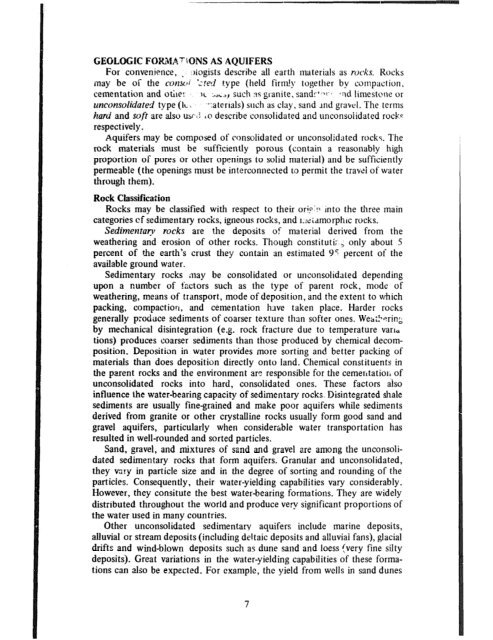Water Well Manual (USAID).pdf - The Water, Sanitation and Hygiene
Water Well Manual (USAID).pdf - The Water, Sanitation and Hygiene
Water Well Manual (USAID).pdf - The Water, Sanitation and Hygiene
Create successful ePaper yourself
Turn your PDF publications into a flip-book with our unique Google optimized e-Paper software.
IC FQRXA~NMIIS AS AQUIFERS<br />
For convenience, . :)iogists describe all earth materials as roclis. Rocks<br />
may be of the ~~onti.J ‘,-refl type (held firntiy together by compaction,<br />
cementation <strong>and</strong> otLe:, K A~.,P sut!~ :ts granite. s<strong>and</strong>r’,>r-* e;\d limestone or<br />
rtrncomoiidated type (IL, .-:aterials) such as clay, s<strong>and</strong> Jnd gravel. <strong>The</strong> terms<br />
hml <strong>and</strong> soft are also usr,~: r.o describe consolidated <strong>and</strong> unconsolidated rocky<br />
respectively.<br />
Aquifers may be composed of consolidated or unconsolidated rocks. <strong>The</strong><br />
rock materiais must be sufficiently porous (contain a reasonably high<br />
proportion of pores or other openings to solid material) <strong>and</strong> be sufficiently<br />
permeable (the openings must be interconnected to permit the travei of water<br />
through them).<br />
Rock Classification<br />
Rocks may be classified with respect to their or+;? into the three main<br />
categories cf sedimentary rocks, igneous rocks, <strong>and</strong> lxidmorphic rocks.<br />
Sedimentary rocks are the deposits of material derived from the<br />
weathering <strong>and</strong> erosion of other rocks. Though constituti;.; only about 5<br />
percent of the earth’s crust they contain an estimated 95 percent of the<br />
available ground water.<br />
Sedimentary rocks may be consolidated or unconsolidated depending<br />
upon a number of ?‘zctors such as the type of parent rock, mode of<br />
weathering, means of transport, mode of deposition, <strong>and</strong> the extent to which<br />
packing, compactiorl, <strong>and</strong> cementation have taken place. Harder rocks<br />
generally produce sediments of coarser texture than softer ones. Web;>erin;<br />
by mechanical disintegration (e.g. rock fracture due to temperature varlu<br />
tions) produces coarser sediments than those produced by chemical decom-<br />
position. Deposition in water provides more sorting <strong>and</strong> better packing of<br />
materials than does deposition directly onto l<strong>and</strong>. Chemical constituents in<br />
the parent rocks <strong>and</strong> the environment are responsible for the cemerltatioll of<br />
unconsolidated rocks into hard, consolidated ones. <strong>The</strong>se factors aiso<br />
influence the water-bearing capacity of sedimentary rocks. Disintegrated shale<br />
sediments are usually fine-grained <strong>and</strong> make poor aquifers while sediments<br />
derived from granite or other crystalline rocks usually form good s<strong>and</strong> <strong>and</strong><br />
gravel aquifers, particularly when considerable water transportation has<br />
resulted in well-rounded <strong>and</strong> sorted particles.<br />
S<strong>and</strong>, gravel, <strong>and</strong> mixtures of s<strong>and</strong> <strong>and</strong> gravel are among the unconsoli-<br />
dated sedimentary rocks that form aquifers. Granular <strong>and</strong> unconsolidated,<br />
they va.ry in particle size <strong>and</strong> in the degree of sorting <strong>and</strong> rounding of the<br />
particies. Consequently, their water-yielding capabilities vary considerably.<br />
However, they consitute the best water-bearing formations. <strong>The</strong>y are widely<br />
distributed throughout the world <strong>and</strong> produce very significant proportions of<br />
the water used in many countries.<br />
Other unconsolidated sedimentary aquifers include marine deposits,<br />
alluvial or stream deposits (including deltaic deposits <strong>and</strong> alluviai fans), glacial<br />
drifts <strong>and</strong> wind-blown deposits such as dune s<strong>and</strong> <strong>and</strong> loess [very fine silty<br />
deposits). Great variations in the water-yielding capabilities of these forma-<br />
tions can also be expected. For example, the yield from wells in s<strong>and</strong> dunes<br />
7

















